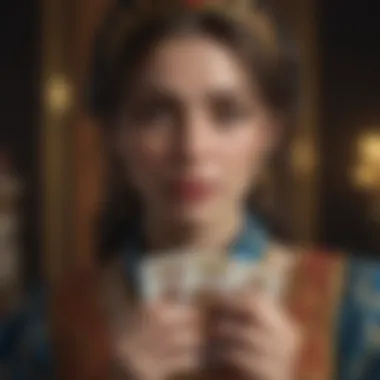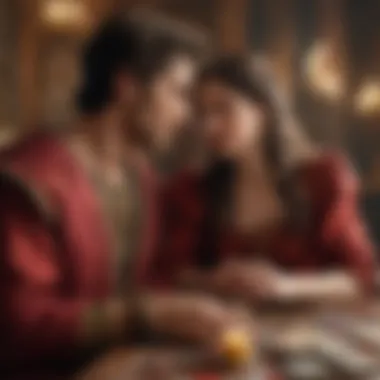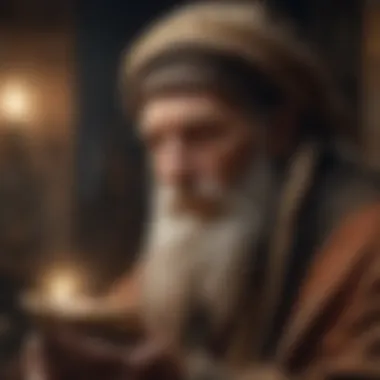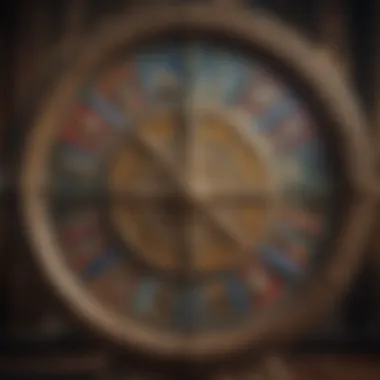Understanding the Impact of Seven Key Tarot Cards


Intro
Tarot cards have been a source of intrigue and analysis for centuries. With their vivid imagery and rich symbolism, they are more than just simple playing cards; they serve as windows into the human psyche and the universality of experience. Through the exploration of seven significant tarot cards, we can glean insights that extend beyond the individual card meanings and into the realm of personal growth, decision-making, and self-reflection. This article seeks to venture into the depths of each card's significance, from its historical roots to its relevance in contemporary life.
The Importance of Tarot Cards in Modern Context
Modern practitioners of tarot frequently face the skepticism surrounding their craft. However, the essence of tarot goes beyond mere fortune-telling. Cards such as the Fool, the Magician, and the High Priestess hold profound messages that can guide individuals through the complicated maze of life. Contrary to the fleeting nature of modern life's distractions, tarot offers a moment of stillness, a chance to reflect on one's choices, and perhaps even a way to chart a future path.
"Tarot represents a path to self-discovery. Engaging with the cards is an invitation to look inward, often revealing truths that may be hidden beneath the surface."
In this pursuit, we aim to uncover not just the cards' individual meanings, but also the overarching themes and connections between them, fostering a more holistic understanding of tarot's utility. As we delve into the various aspects, expect to find unique interpretations that challenge conventional views and spark fresh perspectives.
Navigating the Seven Tarot Cards
Throughout this article, various sections will meticulously illuminate the significance of seven tarot cards. Expect a mixture of historical context, astrological associations, and personal reflections. Each card will be treated with respect, recognizing its multi-faceted nature and potential to inspire growth.
By examining both traditional interpretations and contemporary applications, readers will leave equipped with a deeper appreciation and understanding of this esoteric tool. From the novice curious about tarot to the seasoned tarologist seeking to hone their skills, this exploration has something to offer everyone passionate about this ancient art.
Join us on this journey as we dissect and analyze each card, providing insights that cater to both the intellectually curious and the spiritually inclined.
Foreword to Tarot
Tarot serves as a profound tool for understanding the intricate tapestry of human experience. In recent times, the practice has gained momentum, resonating especially with those seeking clarity and guidance in a world full of uncertainties. This article endeavors to peel back layers surrounding tarot, focusing on its pivotal role in personal exploration and decision-making processes.
Understanding tarot is not merely about card distribution or divination; it delves into the psyche, providing insight into one's emotions, motivations, and life paths. Each card holds a universe of meaning, and together, they weave narratives that can illuminate both the ordinary and the extraordinary aspects of life.
Key points to consider in this exploration include:
- The historical roots of tarot and how they shape contemporary interpretations.
- The unique structure of tarot decks, which influences readings.
- The varied applications of tarot beyond traditional practices, emphasizing self-awareness and personal growth.
Grasping these elements can aid individuals in harnessing tarot's potential to cultivate a deeper connection with themselves and their environment. Tarot isn’t simply an esoteric pursuit; it bridges the gap between the known and unknown, offering seekers a way to reflect and understand—both their inner worlds and their place in the grand scheme of things.
Historical Background
The history of tarot dates back to the 15th century, with its roots entrenched in Europe. Initially conceived as playing cards, these decks gradually evolved into tools of divination by the 18th century. The transition from simple amusements to mystical artifacts illustrates how society’s views on spirituality and foresight shifted over time.
Ancient tarot decks using images rooted in European mysticism show how even then, practitioners tapped into symbolism that reflects deeper meanings. The Marseille deck, for instance, remains a prevalent example, showcasing rich iconography that conveys distinct meanings through its visual language. Moreover, the subsequent emergence of the Rider-Waite deck in the early 20th century brought about a significant turning point, offering clearer imagery and narratives that shaped modern-day readings.
Understanding Tarot Structure
Exploring tarot’s structural framework offers crucial insight into its functionality. Generally composed of 78 cards, the tarot deck splits into two primary segments: the Major Arcana and the Minor Arcana. The Major Arcana comprises 22 cards—each one embodying key archetypes and significant life themes. Cards like The Fool and The High Priestess resonate on a universal level, symbolizing fundamental aspects of the human journey.
The Minor Arcana, on the other hand, consists of 56 cards that delve into day-to-day experiences and interactions. This segment is divided into four suits—Wands, Cups, Swords, and Pentacles—each representing different spheres of life. Understanding the balance within this structure aids in interpreting readings, where the interplay of Major and Minor Arcana can signify broader life lessons or day-to-day challenges.
Through a careful analysis of these layers, readers can better appreciate not merely the story each card tells but how they interconnect and weave narratives reflective of their lives. In essence, beckoning clarity through confusion and lending a framework to the unpredictability of existence.


The Role of Tarot in Modern Contexts
The role of tarot today stretches beyond mere card readings, burrowing deep into the fabric of modern spiritual practices and self-awareness journeys. For many, tarot serves not only as a tool for predicting future events but also as a mirror reflecting the inner workings of one's mind and spirit. In today’s world, where daily life can feel like trying to catch smoke with bare hands, seeking clarity and understanding from tarot has never been more significant.
Tarot as a Tool for Self-Discovery
Self-discovery is a journey that never truly ends. Each card in a tarot deck has the capacity to hold a mirror to our souls, revealing layers of unspoken thoughts and feelings. In this chaotic age, where distractions are aplenty, tarot reading offers a moment of pause.
Engaging with tarot can lead to:
- Increased Self-Awareness: The process of card selection and interpretation often brings personal thoughts to the forefront, aligning one’s innermost desires with external circumstances.
- Reflection on Life Choices: Each card can represent different paths or decisions, prompting us to evaluate our choices and considerations.
- Guidance Through Uncertainty: At times, uncertainty feels like a heavy fog. Tarot illuminates potential pathways, acting as a compass that can guide through murky waters.
After pulling certain cards, like The Fool, one might think about taking risks or embracing new experiences. In contrast, drawing The High Priestess may lead a person to consider the importance of trusting their intuition. Thus, tarot can reshape perception, inviting fresh perspectives and encouraging personal growth.
The Therapeutic Benefits of Card Reading
The therapeutic aspect of tarot reading cannot be overstated. It combines art, tradition, and psychological insight, carving a niche in holistic wellness. Whether done in a group or in solitude, this practice opens doors to emotional healing.
Card reading serves as a profound form of therapy. Many find it therapeutic due to the time spent reflecting on their lives and emotions while interpreting cards. Here's how:
- Emotional Release: Voicing concerns and questions while drawing cards can help release pent-up emotions. The act of sharing one's thoughts, even if just with oneself, allows the heart to breathe.
- Clarity in Chaos: Tarot can help bring clarity during tumultuous times. It helps individuals untangle intricate feelings and see their situations from new angles.
- Empowerment: Engaging with tarot reinforces the understanding that individuals have power over their lives. The cards can illuminate paths, but choices ultimately reside in the hands of the seeker.
As many become seekers of meaning and insight, tarot reading stands as a bridge between the intangible and the practical. The integration of tarot into one’s daily rituals or decision-making enhances the connection between self-awareness and the understanding of life’s complexities.
Symbolism of the Seven Tarot Cards
The symbolism of the seven tarot cards serves as the very backbone of tarot wisdom, revealing layers of meaning and interpretation that connect deeply with the human experience. In this exploration, we unveil how each card acts as a mirror, reflecting our innermost thoughts, emotions, and desires. Each symbol is rich with potential insights, guiding those who engage with them toward greater self-awareness and understanding.
These cards aren't just pieces of artwork or fancy illustrations; they are conduits of powerful energies that help individuals navigate their realities. The images and symbols encapsulate a wealth of historical, cultural, and psychological layers, making them relevant to anyone seeking clarity in their lives.
One could say that the tarot cards are like keys—unlocking doors to hidden aspects of ourselves and our situations. The study of each card's symbolism can help in grasping the nuances of life's experiences, making the journey of discovery as engaging as it is illuminating.
Moreover, understanding these symbols can inform one’s decision-making processes. Pick a card, and you might not just find a representation of where you are but also the potential pathway ahead. Symbolism thus becomes a bridge between our present and potential future, signaling opportunities, challenges, and everything in between.
"Tarot doesn't predict the future; it reveals the landscape of your choices."
The Fool: Embracing New Beginnings
The Fool card heralds new beginnings and limitless possibilities. Often depicted with a carefree spirit, the Fool stands at the brink of something new, signifying a leap of faith. This card encourages one to embrace spontaneity without fear of the unknown, resonating with the idea that every journey begins with a single step.
In practical terms, interpreting the Fool often involves contemplating what it means to approach life with a fresh mindset. It suggests abandoning stale ideas or limiting beliefs that hinder growth. Finding yourself drawn to this card may suggest you're at a point where taking a risk could lead to transformative experiences.
The Magician: Manifestation and Power
The Magician card represents personal power and transformation. Symbolizing action and the ability to manifest desires into reality, this card reveals that you have all the tools necessary to create your destiny. It's not just about having resources; it's about recognizing your potency as an individual.


Engaging with the symbolism of the Magician means tapping into your inherent skills and talents. Whether you're looking to start a project or make a life change, this card embodies the idea that focused intent and effort can yield fruitful results.
The High Priestess: Intuition and Inner Wisdom
The High Priestess symbolizes intuition, deep knowledge, and the mysteries of the subconscious. Her connection to the spiritual realm invites reflection on what lies below the surface of our everyday consciousness. When this card appears, it's a nudge to trust your instincts and pay attention to your dreams and intuition.
This card's significance lies in the reminder that not all knowledge is found in books; some truths are felt and understood internally. The High Priestess beckons you to explore your inner landscapes, encouraging a deeper understanding of yourself and the world around you.
The Empress: Nurturing and Abundance
Representing fertility, abundance, and nurturing, the Empress embodies the essence of feminine energy. Her imagery often includes elements of nature and growth, symbolizing the importance of nurturing both oneself and others. When drawn, the Empress may indicate the need to focus on self-care, creativity, and connections in your relationships.
In a broader sense, this card speaks to the wealth of resources available to you. Engaging with the Empress urges recognition of all that you have and invites you to cultivate a mindset of gratitude and generosity.
The Emperor: Authority and Structure
The Emperor personifies authority, stability, and structure. Often depicted as a figure of power, this card signifies the need for control and order in various aspects of life. It encourages the establishment of rules and boundaries which can lead to greater success in professional and personal endeavors.
Recognizing the value of the Emperor’s symbolism can prove significant in a period of upheaval. Sometimes this card surfaces as a reminder to take charge, set your goals clearly, and lead with confidence. By adhering to the Emperor's wisdom, one can navigate challenges with strength and composure.
Understanding the symbolism of these seven tarot cards enriches one's journey into self-discovery and the complexities of life. Each card offers insights about where you might find yourself and how to steer your course effectively.
Practical Applications of the Seven Tarot Cards
Understanding the practical applications of tarot cards can transform the way individuals approach life's turns and twists. Tarot serves not just as a mystical guide but as a reliable companion in navigating challenges and discovering personal insights. When used consciously, these cards can enrich daily decision-making and self-reflection practices. By engaging with the seven essential tarot cards, one can absorb their individual energies and essentially apply them to real-life situations.
The use of tarot in day-to-day life may vary from casual card draws to formal readings. One key element of these practical applications is being intentional and consistent in your practice. Almost like the act of planting a seed and nurturing it until it blooms, engaging with these tarot cards fosters an enriching dialogue between the self and the universe.
Daily Card Draw: Rituals and Reflections
Daily card draws can act as a compass, pointing individuals toward personal growth or revealing underlying themes in their lives. To make the most of this practice, one might set aside some time each morning for a quiet ritual. Here’s how to structure this ritual:
- Find a Quiet Space: Choose a tranquil spot where one feels at ease. This creates a conducive atmosphere for reflection.
- Shuffle the Deck: As you shuffle, think of a specific question or simply ask for guidance for the day ahead.
- Draw One Card: Pull a single card from the deck and observe your immediate reactions. What thoughts or feelings arise?
- Reflect on the Card's Meaning: Investigate the symbolism behind the card. What does it represent in the context of your life?
- Journal Your Insights: Document your reflections in a journal. This helps solidify insights and trace patterns over time.
Daily card draws reveal hidden themes and invite personal insights, aiding in understanding life’s rhythms.
This simple yet profound routine encourages mindfulness and reflection, helping individuals remain aware of their feelings and actions throughout the day. The card drawn serves not only as a symbol but as a prompt for deeper contemplation on various aspects of life.
Incorporating Tarot into Decision-Making
When faced with choices, tarot can be an invaluable resource. Rather than serving solely as a fortune-telling tool, it can assist in complex decision-making processes. To integrate the cards into your decision framework, consider the following steps:
- Define the Choices: Clearly outline the decisions that need to be made. Listing pros and cons can also be beneficial.
- Select a Spread: Choose a card spread that resonates. For instance, a three-card spread—covering past influences, present circumstances, and future outcomes—can offer insights into the scenario at hand.
- Interpret the Cards: As each card is drawn and laid out, contemplate its relevance to your situation. How does each card inform your choices?
- Evaluate the Insights: Review the reading as a whole. Does it resonate with your intuition?
- Take Action: Remember that tarot provides guidance but does not dictate decisions. It’s crucial to blend your own intuition with the insights drawn from the cards.
Utilizing tarot in this way can illuminate paths that may not have been considered otherwise. It encourages a deeper analysis of the subtle energies surrounding decisions, which often prompts thoughtful actions rather than rushed responses.


The integration of tarot into day-to-day life provides a platform for introspection and empowerment. Whether it’s through daily rituals or as a decision-making aid, knowledge of these seven tarot cards can profoundly impact one’s personal journey.
Integration of Tarot with Other Spiritual Practices
The world of tarot is often viewed in isolation, but its true potential comes to light when woven into the fabric of other spiritual practices. Integrating tarot with methods like astrology and meditation enriches the reading experience, providing a multidimensional approach to personal insight and spiritual growth. Bringing together these practices allows individuals to tap into a broader spectrum of messages and vibrations, fostering self-awareness and clarity in one's path.
When discussing the integration of tarot with other spiritual practices, several key benefits emerge:
- Holistic Understanding: By combining tarot with astrology, practitioners can align their readings with celestial movements, thus adding layers of cosmic perspective.
- Deepened Insights: Incorporating meditation techniques with card readings can enhance focus and allow for a more profound connection with one's inner self and the messages the cards convey.
- Variety in Interpretation: Each spiritual practice enriches the tarot experience by bringing in unique symbols, rituals, and philosophies which can deepen one’s intuitive responses and interpretations.
It’s worth noting that while this integration has its perks, practitioners should always approach it with an open yet discerning mindset. Striking the right balance between the diverse practices ensures that one does not lose the core essence of each system, but rather allows them to inform and enhance each other.
Tarot and Astrology: Linking Cosmic Forces
Astrology and tarot share an intertwined history, both serving as tools for divination and insight. Each tarot card is often linked to specific astrological signs, houses, or planets which can dramatically influence readings. For instance, the Magician card, often associated with the planet Mercury, embodies communication and manifestation, resonating perfectly with Gemini and Virgo qualities.
By exploring astrological correspondences, individuals gain new perspectives on their readings. For instance:
- A card associated with the Moon, like The High Priestess, invites interpretations about intuition and emotional depth, urging one to trust their inner voice.
- A card representing Mars, such as The Emperor, emphasizes themes of assertiveness, structure, and authority.
By considering astrological influences, tarot practitioners can link their readings to the cosmic energies at play, facilitating a fuller interpretation. This connection invites users to reflect not only on their personalities and situations but also on the larger astrological trends affecting them on a given day. In this way, the melding of tarot and astrology becomes a means of personalized guidance, helping users navigate life’s complexities with greater awareness.
Combining Tarot with Meditation Techniques
Integrating meditation into tarot practice presents a unique opportunity to deepen the connection between the self and the cards. Meditation cultivates a calm, introspective mindset, setting the stage for more insightful and meaningful readings. Here’s how one can blend these two practices effectively:
- Pre-reading Meditation: Before drawing cards, spending a few moments in meditation can clear the mind, heightening awareness and preparing one to receive messages without distractions.
- Focused Visualization: After drawing cards, meditative visualization helps practitioners connect with the imagery and symbols on a deeper level. For example, visualizing oneself in the vibrant landscape of the Fool card can invite a feeling of adventure and renewal.
- Post-reading Reflection: Once a tarot session concludes, meditative practices can assist in processing and integrating insights gained during the reading. Journaling or simply sitting in silence can allow those realizations to settle and manifest into actionable steps.
"Merging tarot with meditation doesn’t merely enhance one’s practice; it transforms reading into a sacred ritual where insight blossoms and clarity reigns."
Collectively, these integrations highlight a dynamic interplay between the cards and the universe. By embracing such holistic approaches, practitioners can unlock unprecedented depths of wisdom, guiding them on their personal journeys.
Ending: Unlocking the Wisdom of the Seven Cards
The journey through the seven tarot cards culminates in a profound understanding of their wisdom. This conclusion weaves together the threads explored throughout the article, shedding light on their significance not merely as divinatory tools, but as guides for personal exploration and decision-making. Each card reveals layers of meaning that can mirror our experiences, fears, and aspirations, shedding insight that aids in our growth as individuals.
These seven cards have the power to act as a compass, steering us through our life's uncertainties. So when we take a moment to reflect on their symbols and lessons, we open ourselves up to transformative knowledge that may reshape how we perceive ourselves and our surroundings. It's about recognizing that these cards do not dictate fate, but rather provide perspectives that can clarify our pathways.
Reflecting on Personal Growth
Engaging with each tarot card helps to illuminate personal development. For instance, The Fool encourages us to embrace our vulnerabilities—to step into the unknown with a child's curiosity. When reflecting on such themes during readings, one might find personal growth portrayed in the stories the cards tell.
By regularly engaging with these cards, individuals often uncover hidden strengths and weaknesses. The Magician illustrates the power we hold within to manifest our desires. This card urges reflection on how much of our reality is shaped by our actions and intentions. Through the reflections sparked by the cards, we often come face-to-face with our desires, fears, and the potential barricades we built along our paths.
In short, these cards serve as mirrors of our inner landscapes, inviting us to participate in active self-examination and growth.
Gaining Clarity and Insight
The wisdom encapsulated in the seven tarot cards offers more than just anecdotes; it enhances clarity in both thought and action. Each card presents a unique lens through which to view the world around us. The High Priestess, for instance, advocates for the wisdom of intuition and understanding internal truths. When we let this card connect with our consciousness, we can tap into deeper insights that often elude the busy mind.
Moreover, drawing the Empress encourages acknowledgment of nurturing aspects—both for oneself and for others. This comprehension can lead to clearer perspectives in relationships and personal priorities. Thus, gaining insight from these cards not only enriches our individual journeys but also provides a course for better decision-making.
Ultimately, as we glean the lessons and wisdom each card presents, we create a more nuanced understanding of ourselves and the world. Tarot is a dynamic dance of interpretations and connections, and this ongoing engagement helps us navigate life's complexities with newfound clarity. These cards invite a thoughtful embrace of life's journey, urging us to remain open to the insights that lie ahead.







